中职英语教学法AviationEnglish
中职英语教案课件ppt课件ppt

meanings) and antonyms (words with opposite meanings) and
give examples of each
03
Skill improvement
Reading skills
Reading comprehension
Provide exercises and activities to improve students' ability to understand and analyze the content of the text
Provide opportunities for students to practice giving presentations, focusing on voice control, language clarity, and audience engagement
Debate and discussion
Course outline
Business negotiations and deals with clients Unit 3: Cross cultural Communication
Understanding cultural differences in business communication
Subordinate
clauses
Teach students how to recognize and analyze sub ordinate clauses, including their structure and function in sentences
Vocabulary knowledge
Oral skills
中职英语教案范文全英文版
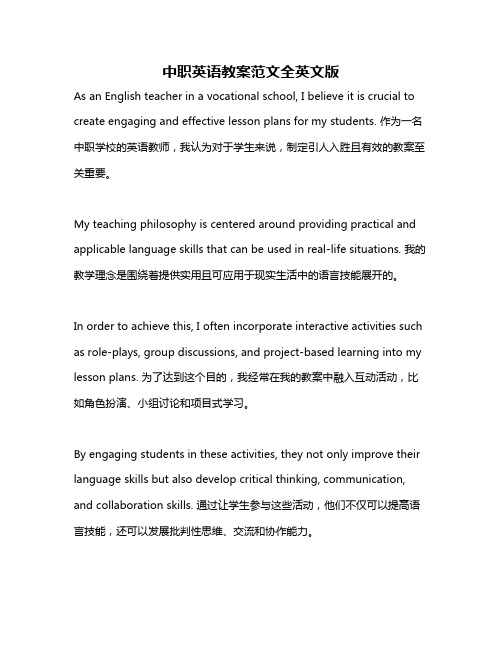
中职英语教案范文全英文版As an English teacher in a vocational school, I believe it is crucial to create engaging and effective lesson plans for my students. 作为一名中职学校的英语教师,我认为对于学生来说,制定引人入胜且有效的教案至关重要。
My teaching philosophy is centered around providing practical and applicable language skills that can be used in real-life situations. 我的教学理念是围绕着提供实用且可应用于现实生活中的语言技能展开的。
In order to achieve this, I often incorporate interactive activities such as role-plays, group discussions, and project-based learning into my lesson plans. 为了达到这个目的,我经常在我的教案中融入互动活动,比如角色扮演、小组讨论和项目式学习。
By engaging students in these activities, they not only improve their language skills but also develop critical thinking, communication, and collaboration skills. 通过让学生参与这些活动,他们不仅可以提高语言技能,还可以发展批判性思维、交流和协作能力。
I also believe in the importance of incorporating real-world examples and cultural references into my lessons to make the content more relatable and interesting for students. 我还相信在我的课堂中融入现实世界的例子和文化参考对于让学生更容易理解和感兴趣。
职高英语教案
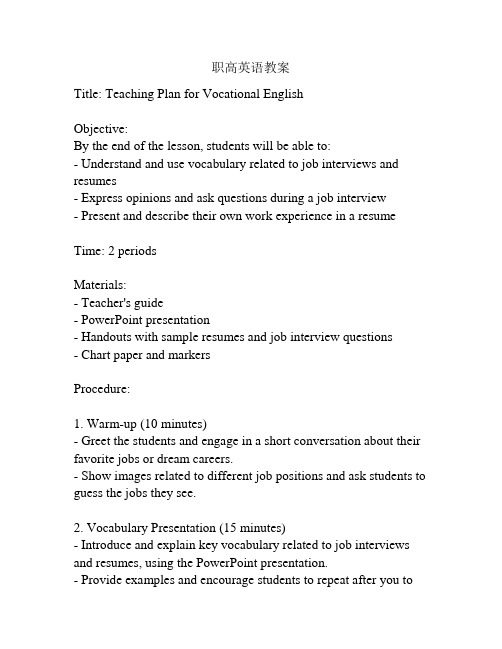
职高英语教案Title: Teaching Plan for Vocational EnglishObjective:By the end of the lesson, students will be able to:- Understand and use vocabulary related to job interviews and resumes- Express opinions and ask questions during a job interview- Present and describe their own work experience in a resume Time: 2 periodsMaterials:- Teacher's guide- PowerPoint presentation- Handouts with sample resumes and job interview questions- Chart paper and markersProcedure:1. Warm-up (10 minutes)- Greet the students and engage in a short conversation about their favorite jobs or dream careers.- Show images related to different job positions and ask students to guess the jobs they see.2. Vocabulary Presentation (15 minutes)- Introduce and explain key vocabulary related to job interviews and resumes, using the PowerPoint presentation.- Provide examples and encourage students to repeat after you topractice pronunciation and memorize the words.- Write the vocabulary on the chart paper to create a visible word wall for the class.3. Group Activity: Job Interview Questions (20 minutes)- Divide the class into small groups and distribute the handout with sample job interview questions.- Instruct the groups to take turns asking and answering the questions, simulating a job interview situation.- Encourage students to use the vocabulary introduced earlier and provide feedback and support as needed.4. Presentation: Work Experience (20 minutes)- Explain the importance of presenting work experience effectively in a resume.- Show students examples of resumes and guide them through the structure and content of each section.- Hand out a template for a resume and allow students some time to fill out their own work experience, using the examples as a guide.5. Pair Activity: Resume Review (20 minutes)- Pair up the students and have them exchange their resumes.- Instruct each pair to review and ask questions about each other's resumes, providing feedback and suggestions for improvement.- Monitor and offer guidance when needed.6. Consolidation and Closure (15 minutes)- Review the vocabulary related to job interviews and resumes, using the word wall.- Ask students to share their experience during the job interview simulation and reflect on what they have learned.- Summarize the key points covered in the lesson and answer any remaining questions.Extension Activity:Assign students to bring in a job advertisement of their choice, and ask them to create a hypothetical resume tailored to the requirements of that job. They can present their resume in class and explain how they match the job requirements. Assessment:Formative assessment will be conducted throughout the lesson by monitoring students' active participation in group discussions, pair activities, and class discussions. The final resume created by each student will also be assessed based on the clarity and presentation of their work experience.。
中职英语的有效教学法探究
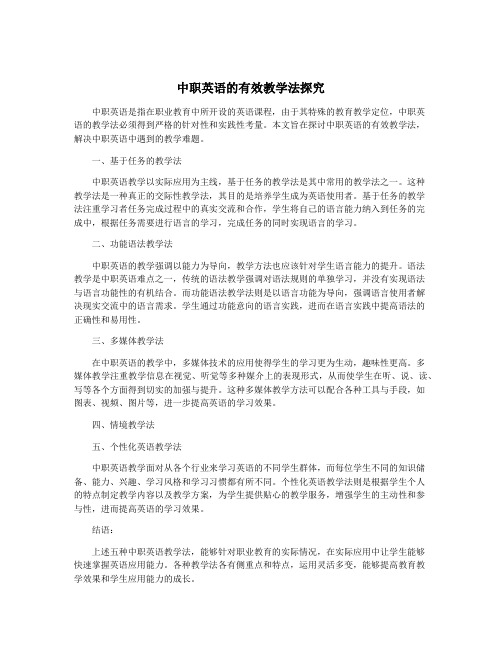
中职英语的有效教学法探究中职英语是指在职业教育中所开设的英语课程,由于其特殊的教育教学定位,中职英语的教学法必须得到严格的针对性和实践性考量。
本文旨在探讨中职英语的有效教学法,解决中职英语中遇到的教学难题。
一、基于任务的教学法中职英语教学以实际应用为主线,基于任务的教学法是其中常用的教学法之一。
这种教学法是一种真正的交际性教学法,其目的是培养学生成为英语使用者。
基于任务的教学法注重学习者任务完成过程中的真实交流和合作,学生将自己的语言能力纳入到任务的完成中,根据任务需要进行语言的学习,完成任务的同时实现语言的学习。
二、功能语法教学法中职英语的教学强调以能力为导向,教学方法也应该针对学生语言能力的提升。
语法教学是中职英语难点之一,传统的语法教学强调对语法规则的单独学习,并没有实现语法与语言功能性的有机结合。
而功能语法教学法则是以语言功能为导向,强调语言使用者解决现实交流中的语言需求。
学生通过功能意向的语言实践,进而在语言实践中提高语法的正确性和易用性。
三、多媒体教学法在中职英语的教学中,多媒体技术的应用使得学生的学习更为生动,趣味性更高。
多媒体教学注重教学信息在视觉、听觉等多种媒介上的表现形式,从而使学生在听、说、读、写等各个方面得到切实的加强与提升。
这种多媒体教学方法可以配合各种工具与手段,如图表、视频、图片等,进一步提高英语的学习效果。
四、情境教学法五、个性化英语教学法中职英语教学面对从各个行业来学习英语的不同学生群体,而每位学生不同的知识储备、能力、兴趣、学习风格和学习习惯都有所不同。
个性化英语教学法则是根据学生个人的特点制定教学内容以及教学方案,为学生提供贴心的教学服务,增强学生的主动性和参与性,进而提高英语的学习效果。
结语:上述五种中职英语教学法,能够针对职业教育的实际情况,在实际应用中让学生能够快速掌握英语应用能力。
各种教学法各有侧重点和特点,运用灵活多变,能够提高教育教学效果和学生应用能力的成长。
中职英语试讲语法课教案

中职英语试讲语法课教案Title: Lesson Plan for Teaching Grammar in Vocational English。
I. Objectives:To introduce students to the basic concepts of grammar in English。
To help students understand the importance of grammar in effective communication。
To provide students with practical examples and exercises to reinforce their understanding of grammar rules。
II. Materials:Whiteboard and markers。
Handouts with grammar exercises。
Examples of sentences for analysis。
PowerPoint presentation (optional)。
III. Introduction:Greet the students and introduce the topic of the lesson: "Today, we will be discussing the basics of grammar in English. Grammar is the foundation of any language, and it is essential for effective communication. By the end of this lesson, you will have a better understanding of how grammar works and why it is important."IV. Presentation:Define grammar: "Grammar is the set of rules that govern the structure of sentencesin a language. It includes rules for word order, verb tenses, parts of speech, and punctuation."Explain the parts of speech: noun, pronoun, verb, adjective, adverb, preposition, conjunction, and interjection. Provide examples of each and ask students to identify the parts of speech in sentences.Discuss verb tenses: present, past, and future. Explain the formation of each tense and provide examples. Have students practice conjugating verbs in different tenses.Introduce subject-verb agreement: "A singular subject requires a singular verb, and a plural subject requires a plural verb." Provide examples and ask students to identify the correct verb form in sentences.Explain the use of articles (a, an, the) and demonstrate when to use each one. Provide examples and have students practice using articles in sentences.Discuss the importance of punctuation: periods, commas, question marks, and exclamation points. Explain the rules for using each type of punctuation and provide examples for students to analyze.V. Practice:Hand out worksheets with grammar exercises for students to complete individually or in pairs. The exercises should cover the topics discussed in the presentation, including parts of speech, verb tenses, subject-verb agreement, articles, and punctuation.Review the answers as a class and provide explanations for any incorrect responses. Encourage students to ask questions and seek clarification on any concepts they find challenging.VI. Application:Provide students with a set of sentences to analyze for grammar errors. Have them identify and correct any mistakes in the sentences, applying the rules they have learned in the lesson.Ask students to create their own sentences using the grammar rules discussed in the lesson. Encourage them to be creative and use a variety of sentence structures and tenses.VII. Assessment:Administer a short quiz to assess students' understanding of the grammar concepts covered in the lesson. The quiz should include multiple-choice and fill-in-the-blank questions related to parts of speech, verb tenses, subject-verb agreement, articles, and punctuation.Review and grade the quizzes to gauge students' comprehension of the material.VIII. Conclusion:Summarize the key points of the lesson: "Today, we have learned about the basic concepts of grammar in English, including parts of speech, verb tenses, subject-verb agreement, articles, and punctuation. Remember that grammar is essential for clear and effective communication in English. Practice using these rules in your writing and speaking to improve your language skills."IX. Homework:Assign homework that reinforces the grammar concepts covered in the lesson, such as completing a set of exercises or writing a short paragraph using the grammar rules discussed.X. Follow-up:In the next lesson, review the homework assignments and address any lingering questions or concerns about the grammar concepts. Provide additional practice opportunities to solidify students' understanding of the material.By following this lesson plan, students will gain a solid foundation in English grammar and be better equipped to communicate effectively in both written and spoken English.。
中职学科教学计划英语

中职学科教学计划英语English Teaching Plan for Secondary Vocational Education.I. Introduction.In the context of globalization and the ever-increasing demand for skilled professionals with cross-cultural communication abilities, English has become an indispensable tool in vocational education. This teaching plan aims to outline a comprehensive English curriculum for secondary vocational students, focusing on developing their language proficiency, vocational-specific language skills, and cultural awareness.II. Objectives.1. Language Proficiency: To enhance students' basic language skills in listening, speaking, reading, and writing.2. Vocational Language Skills: To cultivate students' ability to communicate effectively in English in their chosen vocational field.3. Cultural Awareness: To foster an understanding and appreciation of English-speaking cultures and promotecross-cultural communication.III. Content and Structure.The English curriculum for secondary vocational students will be structured into four main components: foundational skills, vocational language, cultural studies, and practical application.1. Foundational Skills:Grammar and Vocabulary: Focus on essential grammar structures and vocabulary related to daily life and vocational contexts.Listening and Speaking: Develop students' ability to understand spoken English and communicate effectively in conversational settings.Reading and Writing: Enhance reading comprehension and writing skills, including basic text analysis andwriting for different purposes.2. Vocational Language:Industry-Specific Vocabulary: Introduce terminology and jargon related to the students' chosen vocational field.Workplace Communication: Train students in workplace communication skills.。
中职旅游英语口语教案范文
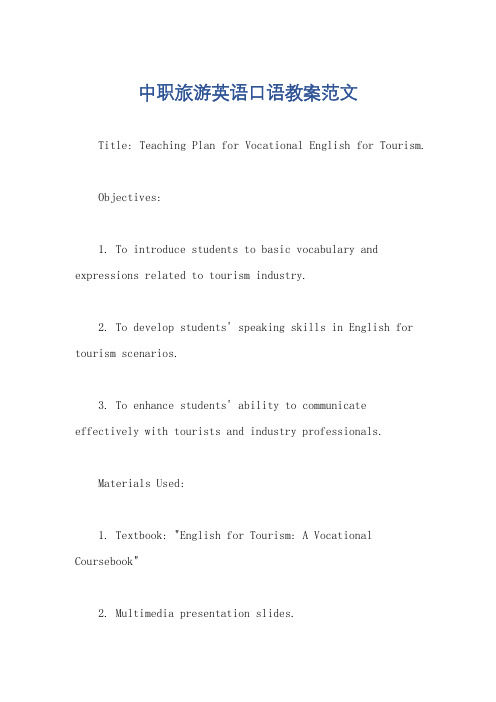
中职旅游英语口语教案范文Title: Teaching Plan for Vocational English for Tourism.Objectives:1. To introduce students to basic vocabulary and expressions related to tourism industry.2. To develop students' speaking skills in English for tourism scenarios.3. To enhance students' ability to communicateeffectively with tourists and industry professionals.Materials Used:1. Textbook: "English for Tourism: A Vocational Coursebook"2. Multimedia presentation slides.3. Role-play scenarios.4. Sample dialogues and scripts.Procedure:Step 1: Introduction (5 minutes)。
Greet the students and introduce the topic of tourism English.Briefly explain the importance of English in the tourism industry and its relevance to their future careers.Step 2: Vocabulary and Expressions (10 minutes)。
Display a PowerPoint slide with key vocabulary and expressions related to tourism.Ask students to read the words aloud and practice pronouncing them correctly.Have a discussion on the meanings and usage of these vocabulary items in tourism contexts.Step 3: Listening Comprehension (10 minutes)。
中职英语教学方法
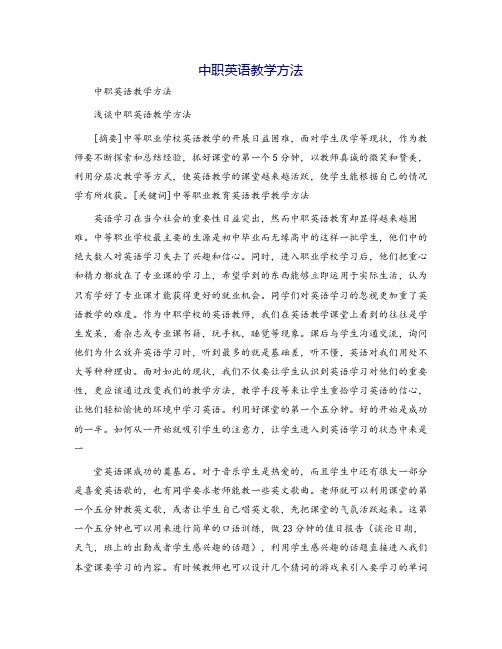
中职英语教学方法中职英语教学方法浅谈中职英语教学方法[摘要]中等职业学校英语教学的开展日益困难,面对学生厌学等现状,作为教师要不断探索和总结经验,抓好课堂的第一个5分钟,以教师真诚的微笑和赞美,利用分层次教学等方式,使英语教学的课堂越来越活跃,使学生能根据自己的情况学有所收获。
[关键词]中等职业教育英语教学教学方法英语学习在当今社会的重要性日益突出,然而中职英语教育却显得越来越困难。
中等职业学校最主要的生源是初中毕业而无缘高中的这样一批学生,他们中的绝大数人对英语学习失去了兴趣和信心。
同时,进入职业学校学习后,他们把重心和精力都放在了专业课的学习上,希望学到的东西能够立即运用于实际生活,认为只有学好了专业课才能获得更好的就业机会。
同学们对英语学习的忽视更加重了英语教学的难度。
作为中职学校的英语教师,我们在英语教学课堂上看到的往往是学生发呆,看杂志或专业课书籍,玩手机,睡觉等现象。
课后与学生沟通交流,询问他们为什么放弃英语学习时,听到最多的就是基础差,听不懂,英语对我们用处不大等种种理由。
面对如此的现状,我们不仅要让学生认识到英语学习对他们的重要性,更应该通过改变我们的教学方法,教学手段等来让学生重拾学习英语的信心,让他们轻松愉快的环境中学习英语。
利用好课堂的第一个五分钟。
好的开始是成功的一半。
如何从一开始就吸引学生的注意力,让学生进入到英语学习的状态中来是一堂英语课成功的奠基石。
对于音乐学生是热爱的,而且学生中还有很大一部分是喜爱英语歌的,也有同学要求老师能教一些英文歌曲。
老师就可以利用课堂的第一个五分钟教英文歌,或者让学生自己唱英文歌,先把课堂的气氛活跃起来。
这第一个五分钟也可以用来进行简单的口语训练,做23分钟的值日报告(谈论日期,天气,班上的出勤或者学生感兴趣的话题),利用学生感兴趣的话题直接进入我们本堂课要学习的内容。
有时候教师也可以设计几个猜词的游戏来引入要学习的单词或短语。
或者贴近学生的生活,鼓励他们去发现身边的英语标识,在课堂和同学们一起分享,学生们很乐意收集就他们身边的信息。
中职英语的有效教学法探究
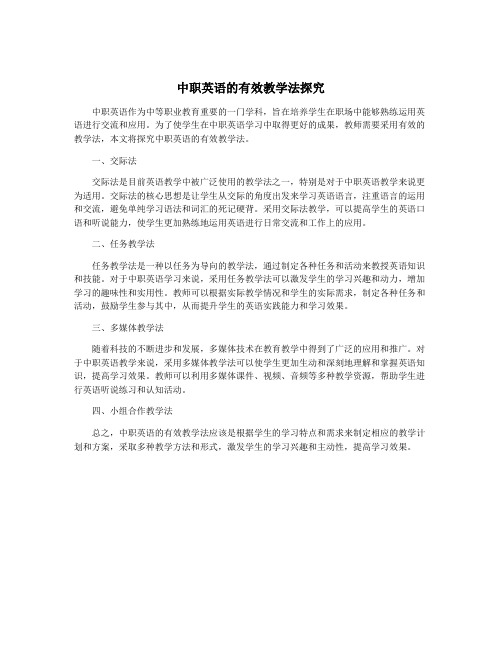
中职英语的有效教学法探究
中职英语作为中等职业教育重要的一门学科,旨在培养学生在职场中能够熟练运用英语进行交流和应用。
为了使学生在中职英语学习中取得更好的成果,教师需要采用有效的教学法,本文将探究中职英语的有效教学法。
一、交际法
交际法是目前英语教学中被广泛使用的教学法之一,特别是对于中职英语教学来说更为适用。
交际法的核心思想是让学生从交际的角度出发来学习英语语言,注重语言的运用和交流,避免单纯学习语法和词汇的死记硬背。
采用交际法教学,可以提高学生的英语口语和听说能力,使学生更加熟练地运用英语进行日常交流和工作上的应用。
二、任务教学法
任务教学法是一种以任务为导向的教学法,通过制定各种任务和活动来教授英语知识和技能。
对于中职英语学习来说,采用任务教学法可以激发学生的学习兴趣和动力,增加学习的趣味性和实用性。
教师可以根据实际教学情况和学生的实际需求,制定各种任务和活动,鼓励学生参与其中,从而提升学生的英语实践能力和学习效果。
三、多媒体教学法
随着科技的不断进步和发展,多媒体技术在教育教学中得到了广泛的应用和推广。
对于中职英语教学来说,采用多媒体教学法可以使学生更加生动和深刻地理解和掌握英语知识,提高学习效果。
教师可以利用多媒体课件、视频、音频等多种教学资源,帮助学生进行英语听说练习和认知活动。
四、小组合作教学法
总之,中职英语的有效教学法应该是根据学生的学习特点和需求来制定相应的教学计划和方案,采取多种教学方法和形式,激发学生的学习兴趣和主动性,提高学习效果。
中职英语教案
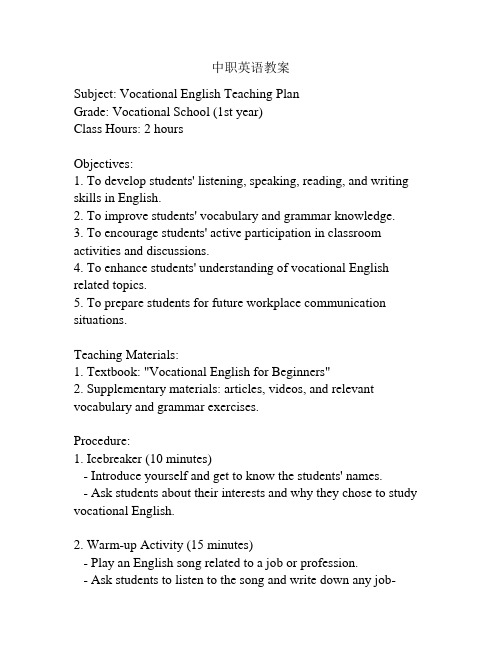
中职英语教案Subject: Vocational English Teaching PlanGrade: Vocational School (1st year)Class Hours: 2 hoursObjectives:1. To develop students' listening, speaking, reading, and writing skills in English.2. To improve students' vocabulary and grammar knowledge.3. To encourage students' active participation in classroom activities and discussions.4. To enhance students' understanding of vocational English related topics.5. To prepare students for future workplace communication situations.Teaching Materials:1. Textbook: "Vocational English for Beginners"2. Supplementary materials: articles, videos, and relevant vocabulary and grammar exercises.Procedure:1. Icebreaker (10 minutes)- Introduce yourself and get to know the students' names.- Ask students about their interests and why they chose to study vocational English.2. Warm-up Activity (15 minutes)- Play an English song related to a job or profession.- Ask students to listen to the song and write down any job-related vocabulary they hear.- Discuss the vocabulary as a class and explain any unfamiliar words.3. Vocabulary Building (20 minutes)- Introduce a set of job-related vocabulary using flashcards or PowerPoint slides.- Have students repeat the words and their meanings.- Conduct pronunciation drills to ensure understanding and correct pronunciation.4. Reading Comprehension (30 minutes)- Provide an article or short passage related to a specific profession.- In pairs or small groups, ask students to read and discuss the passage.- Conduct a class discussion about the main ideas and key details of the passage.- Assign comprehension questions for students to answer individually.5. Speaking Activity (30 minutes)- Divide students into pairs or small groups.- Ask them to discuss a given workplace scenario or problem-solving task.- Encourage students to use the vocabulary and grammar structures learned in the lesson.- Monitor and provide feedback on their spoken English skills.6. Grammar Focus (15 minutes)- Introduce a specific grammar topic such as verb tenses or prepositions.- Provide examples and explanations of the grammar rules.- Engage students in grammar exercises to practice the target structures.7. Wrap-up and Homework (10 minutes)- Review the main points of the lesson and answer any questions. - Assign homework, such as writing a short paragraph about a chosen profession.- Remind students to review the vocabulary and grammar points covered in the lesson.Note: The duration of each activity can be adjusted depending on the students' progress and pace of learning. The teacher should also provide ample opportunities for students to practice their English skills through various class activities and assignments.。
中职英语教学法中职英语教育教学概况PPT学习教案

---information era has made English one of the basic skills for social and personal development;
第26页/共80页
新旧版本的比对
第27页/共80页
1) 新大纲与原大纲的比较 —— 教 学目标的定位
原大纲将中等职业学校英语 课程的教学目标定位在“初中英 语教学的基础上”,以此作为中 职英语课程的起第28页点/共80,页 这一定位符
2)新大纲与原大纲的比较 —— 课程内容结构
原大纲将中等职业学校英语分
数字表明自1945年以来,英语教学急剧扩张,因此David在他的研究中 证明若干年将有20亿人说英语或是在学英语。
第17页/共80页
Implications:
--- English has become as an international language,as a lingua Franca.
中职英语教学的基本理念
1)注重素质教育,提高人文 素养
2)充实基础知识,提高应用 能力
3)突出学生第22主页/共8体0页 ,尊重个体
国家层面 地区层面 学校层面
中职英语教学大纲
第23页/共80页
国家层面: 全国基础外语教育研究培训中心 —— 中职外语教育中心
什么是教学大纲? 为指导英语教学而制订的纲领性文件 规定课程的目的、内容和要求
David Graddol, a British applied linguist who wrote a report about the trend of English for the UK agency, holds that “The future of English lies in the hands of Chinese and Indians ”,“Within a few years there could be around 2bn people learning English”.
中职英语教案ppt课件ppt课件ppt课件

Daily schedule
The weekly plan also includes a daily schedule of activities, including any pre work that needs to be done ahead of time It ensures that all necessary materials and resources are ready for use on each day and that the class is well organized and runs smoothly
Expressions of graduation and apologies
Expressions used to show graduation or apologize
Expressions of conve…
Expressions used to convert or express consolidations
03
Teaching content
01
02
Simple present tense
This is used to talk about regular and bilateral actions
Simple past tense
This is used to talk about actions that happened in the past
Simple future tense
This is used to talk about actions that will happen in the future
Present continuous tense
中职英语的有效教学法探究
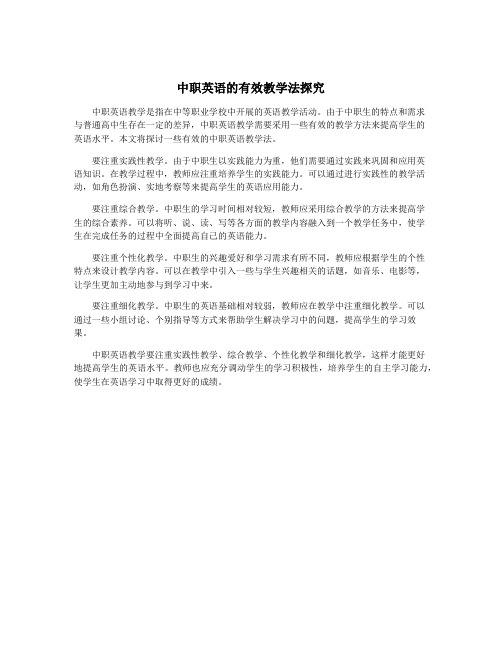
中职英语的有效教学法探究
中职英语教学是指在中等职业学校中开展的英语教学活动。
由于中职生的特点和需求
与普通高中生存在一定的差异,中职英语教学需要采用一些有效的教学方法来提高学生的
英语水平。
本文将探讨一些有效的中职英语教学法。
要注重实践性教学。
由于中职生以实践能力为重,他们需要通过实践来巩固和应用英
语知识。
在教学过程中,教师应注重培养学生的实践能力。
可以通过进行实践性的教学活动,如角色扮演、实地考察等来提高学生的英语应用能力。
要注重综合教学。
中职生的学习时间相对较短,教师应采用综合教学的方法来提高学
生的综合素养。
可以将听、说、读、写等各方面的教学内容融入到一个教学任务中,使学
生在完成任务的过程中全面提高自己的英语能力。
要注重个性化教学。
中职生的兴趣爱好和学习需求有所不同,教师应根据学生的个性
特点来设计教学内容。
可以在教学中引入一些与学生兴趣相关的话题,如音乐、电影等,
让学生更加主动地参与到学习中来。
要注重细化教学。
中职生的英语基础相对较弱,教师应在教学中注重细化教学。
可以
通过一些小组讨论、个别指导等方式来帮助学生解决学习中的问题,提高学生的学习效
果。
中职英语教学要注重实践性教学、综合教学、个性化教学和细化教学,这样才能更好
地提高学生的英语水平。
教师也应充分调动学生的学习积极性,培养学生的自主学习能力,使学生在英语学习中取得更好的成绩。
中职生的英语教学方法探析

中职生的英语教学方法探析1. 引言1.1 背景介绍Background IntroductionWith the rapid development of globalization, English has become an essential skill for individuals seeking success in their careers. In China, vocational education plays a crucial role in preparing students for the workforce, and English is often a required subject in vocational schools. However, teaching English to vocational students presents unique challenges due to their diverse learning styles and backgrounds.1.2 研究目的By examining the challenges faced by vocational students in acquiring English proficiency, we hope to provide insights into the most effective teaching approaches that cater to their needs and learning styles. Additionally, by analyzing real-life case studies and practical examples, we intend to offer concrete methods and techniques that can be implemented in the classroom to improve students' English language proficiency.2. 正文2.1 中职生英语学习特点中职生作为职业教育阶段的学生群体,其英语学习特点主要体现在以下几个方面:中职生的学习目的明确。
中职生的英语教学方法探析
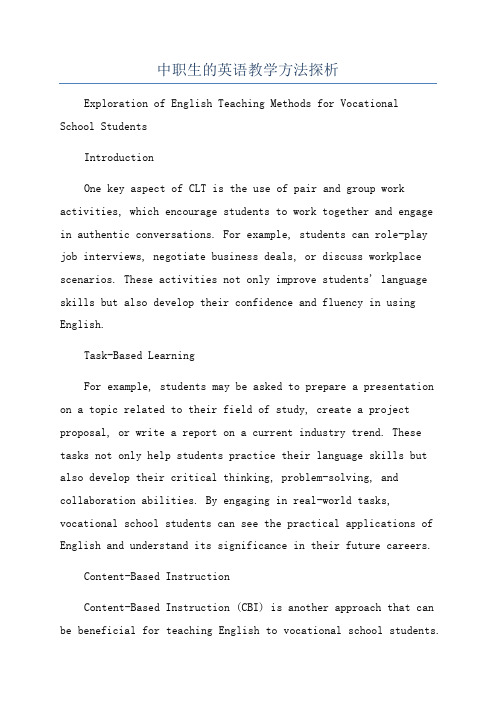
中职生的英语教学方法探析Exploration of English Teaching Methods for VocationalSchool StudentsIntroductionOne key aspect of CLT is the use of pair and group work activities, which encourage students to work together and engage in authentic conversations. For example, students can role-play job interviews, negotiate business deals, or discuss workplace scenarios. These activities not only improve students' language skills but also develop their confidence and fluency in using English.Task-Based LearningFor example, students may be asked to prepare a presentation on a topic related to their field of study, create a project proposal, or write a report on a current industry trend. These tasks not only help students practice their language skills but also develop their critical thinking, problem-solving, and collaboration abilities. By engaging in real-world tasks, vocational school students can see the practical applications of English and understand its significance in their future careers.Content-Based InstructionContent-Based Instruction (CBI) is another approach that can be beneficial for teaching English to vocational school students.In CBI, language learning is integrated with subject matter content, such as information technology, tourism, or healthcare. By teaching English through content, students can develop their language skills while also acquiring knowledge in their specific field of study.For example, students studying hospitality management can learn English by reading and discussing articles about hotel management practices, customer service strategies, and tourism trends. By connecting language learning to their vocational interests, students are more motivated to engage with the material and improve their English proficiency.Conclusion。
中职英语教法
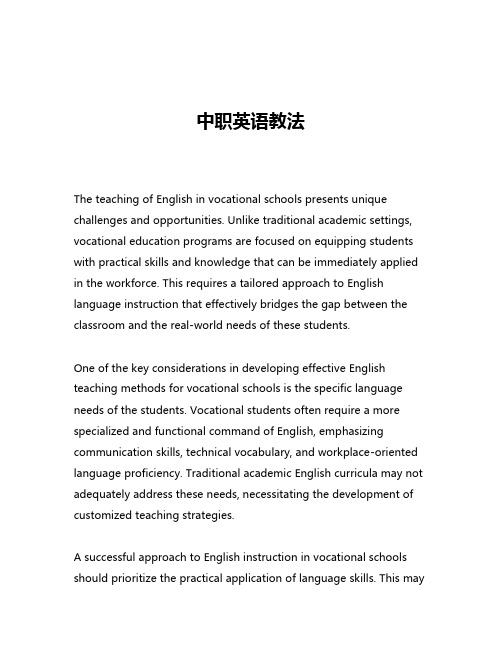
中职英语教法The teaching of English in vocational schools presents unique challenges and opportunities. Unlike traditional academic settings, vocational education programs are focused on equipping students with practical skills and knowledge that can be immediately applied in the workforce. This requires a tailored approach to English language instruction that effectively bridges the gap between the classroom and the real-world needs of these students.One of the key considerations in developing effective English teaching methods for vocational schools is the specific language needs of the students. Vocational students often require a more specialized and functional command of English, emphasizing communication skills, technical vocabulary, and workplace-oriented language proficiency. Traditional academic English curricula may not adequately address these needs, necessitating the development of customized teaching strategies.A successful approach to English instruction in vocational schools should prioritize the practical application of language skills. This mayinvolve incorporating role-playing exercises, simulations, and project-based learning activities that allow students to practice using English in realistic workplace scenarios. By exposing students to authentic communication situations, they can develop the confidence and competence to effectively navigate the linguistic demands of their future careers.Another important consideration is the integration of English language learning with the core vocational curriculum. Rather than treating English as a standalone subject, it can be more effectively taught in the context of the students' technical or vocational specializations. This approach, often referred to as "content-based instruction," enables students to simultaneously develop their English proficiency and their understanding of the subject matter relevant to their field of study.For example, in a vocational program focused on hospitality management, English instruction could be integrated with lessons on customer service, hotel operations, and event planning. By using authentic materials and scenarios from the hospitality industry, students can learn the specialized vocabulary, communication strategies, and language skills needed to excel in their chosen profession.Effective English teaching methods in vocational schools should alsoincorporate a high degree of interactivity and student engagement. Traditional lecture-based approaches may not be as effective in maintaining the attention and motivation of vocational students, who often thrive in more hands-on, collaborative learning environments.Incorporating a variety of instructional techniques, such as group discussions, problem-solving activities, and multimedia presentations, can help to create a more dynamic and engaging learning experience. Additionally, providing opportunities for students to apply their English skills in real-world or simulated contexts can further enhance their understanding and confidence.Another key aspect of English teaching in vocational schools is the need for continuous assessment and feedback. Evaluating student progress not only helps to identify areas for improvement but also allows teachers to adjust their instructional strategies to better meet the needs of their students. This may involve using a combination of formative and summative assessments, as well as providing regular feedback and opportunities for students to reflect on their own learning.One effective approach to assessment in vocational English instruction is the use of performance-based evaluations. These assessments focus on the students' ability to demonstrate theirlanguage skills in practical, job-related scenarios, such as conducting a customer service interaction, delivering a presentation, or participating in a team meeting. By aligning these assessments with the specific language demands of the students' future careers, teachers can better gauge their progress and provide targeted feedback.In addition to the pedagogical considerations, the successful implementation of English teaching methods in vocational schools also requires a strong commitment from both educators and policymakers. This may involve providing comprehensive professional development opportunities for teachers, ensuring access to appropriate teaching resources and materials, and fostering a school culture that values the integration of language learning across the vocational curriculum.Furthermore, collaboration between vocational schools, industry partners, and language education experts can help to ensure that the English instruction provided is closely aligned with the evolving needs of the workforce. By maintaining open lines of communication and incorporating feedback from employers, vocational schools can continuously refine their English teaching methods to better prepare students for the linguistic demands of their future careers.In conclusion, the teaching of English in vocational schools requires amultifaceted approach that prioritizes the practical application of language skills, the integration of English instruction with vocational content, and a high degree of interactivity and student engagement. By adopting these strategies, vocational schools can empower their students to develop the linguistic competence needed to excel in their chosen professions and contribute to the broader economic and social development of their communities.。
浅谈中职英语教学法
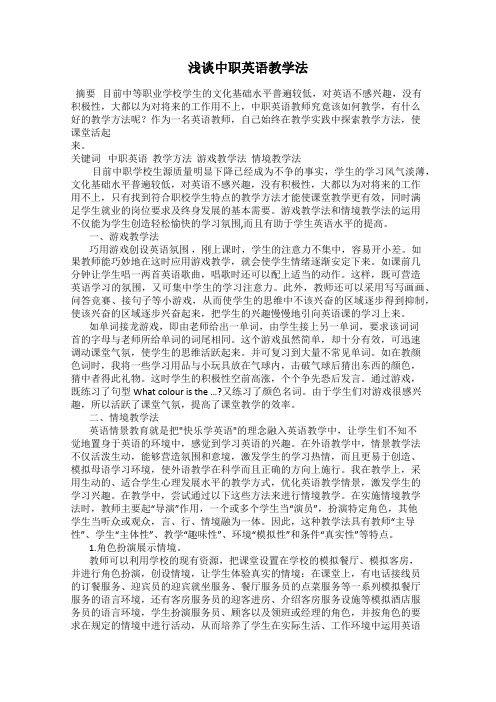
浅谈中职英语教学法摘要目前中等职业学校学生的文化基础水平普遍较低,对英语不感兴趣,没有积极性,大都以为对将来的工作用不上,中职英语教师究竟该如何教学,有什么好的教学方法呢?作为一名英语教师,自己始终在教学实践中探索教学方法,使课堂活起来。
关键词中职英语教学方法游戏教学法情境教学法目前中职学校生源质量明显下降已经成为不争的事实,学生的学习风气淡薄,文化基础水平普遍较低,对英语不感兴趣,没有积极性,大都以为对将来的工作用不上,只有找到符合职校学生特点的教学方法才能使课堂教学更有效,同时满足学生就业的岗位要求及终身发展的基本需要。
游戏教学法和情境教学法的运用不仅能为学生创造轻松愉快的学习氛围,而且有助于学生英语水平的提高。
一、游戏教学法巧用游戏创设英语氛围,刚上课时,学生的注意力不集中,容易开小差。
如果教师能巧妙地在这时应用游戏教学,就会使学生情绪逐渐安定下来。
如课前几分钟让学生唱一两首英语歌曲,唱歌时还可以配上适当的动作。
这样,既可营造英语学习的氛围,又可集中学生的学习注意力。
此外,教师还可以采用写写画画、问答竞赛、接句子等小游戏,从而使学生的思维中不该兴奋的区域逐步得到抑制,使该兴奋的区域逐步兴奋起来,把学生的兴趣慢慢地引向英语课的学习上来。
如单词接龙游戏,即由老师给出一单词,由学生接上另一单词,要求该词词首的字母与老师所给单词的词尾相同。
这个游戏虽然简单,却十分有效,可迅速调动课堂气氛,使学生的思维活跃起来。
并可复习到大量不常见单词。
如在教颜色词时,我将一些学习用品与小玩具放在气球内,击破气球后猜出东西的颜色,猜中者得此礼物。
这时学生的积极性空前高涨,个个争先恐后发言。
通过游戏,既练习了句型What colour is the …?又练习了颜色名词。
由于学生们对游戏很感兴趣,所以活跃了课堂气氛,提高了课堂教学的效率。
二、情境教学法英语情景教育就是把"快乐学英语"的理念融入英语教学中,让学生们不知不觉地置身于英语的环境中,感觉到学习英语的兴趣。
中职英语语音教学
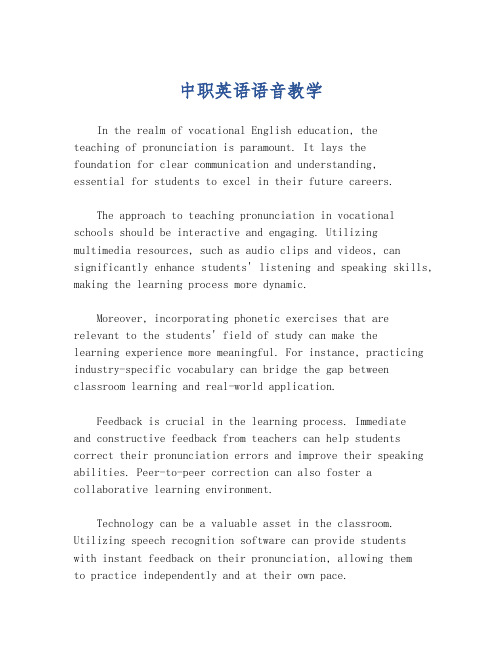
中职英语语音教学In the realm of vocational English education, theteaching of pronunciation is paramount. It lays thefoundation for clear communication and understanding,essential for students to excel in their future careers.The approach to teaching pronunciation in vocational schools should be interactive and engaging. Utilizing multimedia resources, such as audio clips and videos, can significantly enhance students' listening and speaking skills, making the learning process more dynamic.Moreover, incorporating phonetic exercises that are relevant to the students' field of study can make thelearning experience more meaningful. For instance, practicing industry-specific vocabulary can bridge the gap between classroom learning and real-world application.Feedback is crucial in the learning process. Immediateand constructive feedback from teachers can help students correct their pronunciation errors and improve their speaking abilities. Peer-to-peer correction can also foster a collaborative learning environment.Technology can be a valuable asset in the classroom. Utilizing speech recognition software can provide studentswith instant feedback on their pronunciation, allowing themto practice independently and at their own pace.Cultural awareness is an integral part of language learning. Introducing students to different English accents and dialects can broaden their understanding of thelanguage's diversity and prepare them for global communication.Finally, continuous practice is key to mastering pronunciation. Encouraging students to engage in regular speaking activities, such as role-plays and debates, can help them become more confident and fluent in English.In conclusion, effective pronunciation teaching in vocational English education requires a blend of traditional and modern methods, tailored to the students' needs and interests, to ensure they are well-prepared for their professional endeavors.。
- 1、下载文档前请自行甄别文档内容的完整性,平台不提供额外的编辑、内容补充、找答案等附加服务。
- 2、"仅部分预览"的文档,不可在线预览部分如存在完整性等问题,可反馈申请退款(可完整预览的文档不适用该条件!)。
- 3、如文档侵犯您的权益,请联系客服反馈,我们会尽快为您处理(人工客服工作时间:9:00-18:30)。
教学内容
1. 基础英语
高职
Your site here
3. PETS考试、 SCET-3
2. 专业英语
Your site here
专业英语
机务
机务英语
安检
安检英语
航空服务 航空服务英语
空中乘务 客舱英语
Communication & Certificate
1. 词汇 2. 句型 3.广播词/
会话
PETS考试、 SCET-3
1. 时间 2. 类别
培训: 教学方法
广播词
南航托业 英语
教学
基础 英语
案例厦航定 向班客舱英语会话 Nhomakorabea1.
Announcement for Boarding 登机广播
Ladies and Gentlemen
Welcome abroad China Southern Airlines. As you enter the cabin, please take your seat as soon as possible. Your seat number is indicated on the edge of the overhead bins. Please put your carryon baggage in the overhead bin or under the seat in front of you. If you need any assistance, we are glad to help you. We wish you a pleasant journey. Thank you!
3.Aviation English 航空英语
Contents
1. 学情分析 2. 教学内容介绍 3. 教学案例 4. 教学实操
Your site here
学情分析
中职
高职
1. 15 2. 50
Your site here
200/40
教学内容
中职:
基础英语、专业英语
Your site here
教学实操
Thank you !
